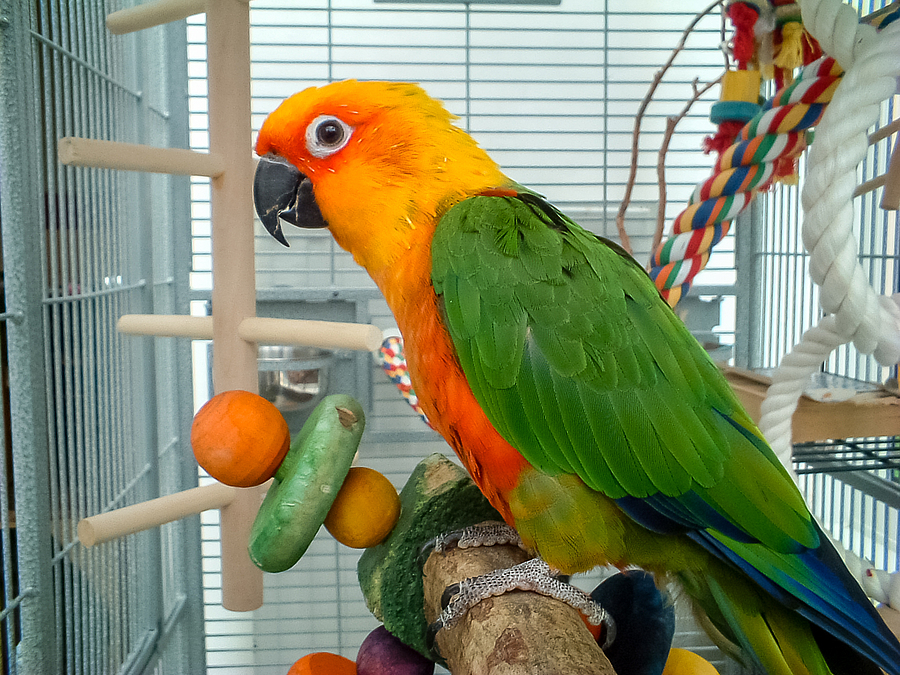Have you ever wondered why toys for pet birds are so intricate, colorful, varied in materials and textures, and downright fun-looking? Could you imagine your hookbill happy with anything less than a toy he can spend hours chewing on, shredding, swinging from, and flinging from side to side?
Our pet birds are highly intelligent creatures. As such, they require enrichment in many forms—including toys. In the wild, parrots use their beaks to forage for food, shred vegetation, and preen themselves. They use their claws to climb, grasp, and perch. In our homes, our pet birds retain those wild instincts, and although they love hanging out with us, they also need to exercise their natural impulses to forage, shred, preen, climb, grasp, and perch. We can provide the enrichment they need, both mentally and physically, by making sure the toys we give them are challenging, entertaining, and fun!
Importance of Playtime
A bored bird can be a destructive (and often anxious) bird. Your pet requires enrichment in his environment, whether in his cage or on his play-stand. While some foods may offer similar opportunities to scavenge, crunch, and destroy (think nuts with the shells on [high-quality, non-salted], raw carrot sticks, and millet sprays), your bird needs to have non-edible toys to occupy his time as well. Physically, birds keep their bills and their nails honed by rubbing and scraping them against branches and other similar items in the wild. Mentally, birds can become anxious if they don’t have something to do. In the wild, that need is assuaged by foraging for food or preening their flock mates. In captivity, a pet bird sitting alone in a cage with only a couple of perches and food dishes can resort to undesirable activities to occupy his mind and time—activities like feather plucking, nail biting, destroying perches, and chewing on cage bars. Thoughtfully chosen and arranged toys of various sizes, colors, and textures help our pet birds stay mentally sharp and physically healthy.
Choosing the Right Types of Toys
Variety is the spice of life when it comes to bird toys. A visit to your local pet store or online pet marketplace may feel overwhelming. You’ll find hanging toys, handheld toys, and toys that attach to the side of the cage. You’ll find playpens that set on the top of the cage (or on a table) and freestanding playpens on casters that you can move from room to room so your parrot can play and enjoy being a part of the household.
The key is to offer your pet different toys to appeal to his different moods. You may want to provide one made of soft wood with pine nuts drilled into it, which encourages your bird to shred to get to the treat. Another could be made of rope or raffia that’s been separated, eliciting preening behavior. Handheld toys give birds the opportunity to stretch and flex their claws, and have the added benefit of encouraging good circulation and foot health.
Whatever toys you choose, make sure they are safe. Parrots can get crazy when they really love a toy, and could end up stuck in a hanging toy that’s too long, or get their claws trapped in toy with a “jingle-type” bell. Use common sense, and monitor your bird as much as you can when he’s playing with his toys. Always make sure to remove toys that may become dangerous as they’re destroyed. Which brings us to the next point.
Taking It Out on the Toy
Bird toys can be pricey. So, buyer, be aware—birds destroy their toys. That’s the point of giving birds toys in the first place. A happy parrot is a parrot that has decimated his toys beyond all recognition. That fellow is getting his physical exercise and keeping his mental health sharp by releasing his natural instincts to shred, forage, and preen. Don’t be surprised if you give your bird an awesome toy in the morning and find it in pieces on the cage floor a few hours later.
Of course, that means keeping your bird consistently occupied with toys can get expensive. If you have a penchant for DIY projects, you’re in luck. You don’t need to be an accomplished artisan or engineer to create some fun toys for your bird with your own two hands.
DIY Toys
Simple can be fun for birds—and a blessing for the casual DIYer. A favorite toy of my lilac-crowned Amazon was a balled-up tissue. I’d crumple a tissue up into a ball and place it on the ground or table in front of him. He’d charge the “ball,” pick it up in his beak, and toss it into the air. He’d do this over and over, “chuckling” in delight with each toss. You can design other simple toys out of millet sprays (make fruit kabobs by skewering soft fruits like strawberries, bananas, mango, and pineapple), cardboard paper towel holders (make sure they don’t have any adhesive on them), popsicle sticks, plastic straws, and untreated (plain, non-inked) paper. Playtime doesn’t have to be a wallet-draining experience!
At the End of the Day
Even though our pet birds enjoy the interaction we have with them, we can’t take the place of toys that provide them the enrichment they need to stay physically and mentally healthy. A pet parrot can spend hours enjoying a toy that features various textures, colors, and destroyable materials—whether that toy is commercially produced or handmade. Staying healthy and happy has never been so much fun!
This article was reviewed/edited by board-certified veterinary behaviorist Dr. Kenneth Martin and/or veterinary technician specialist in behavior Debbie Martin, LVT.








